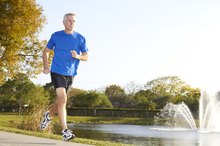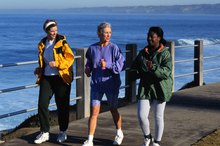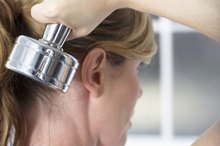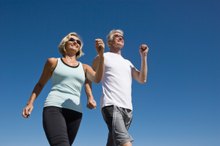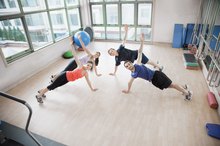What does fact checked mean?
At Healthfully, we strive to deliver objective content that is accurate and up-to-date. Our team periodically reviews articles in order to ensure content quality. The sources cited below consist of evidence from peer-reviewed journals, prominent medical organizations, academic associations, and government data.
- Harvard School of Public Health: Staying Active
- American Heart Association: Physical Activity Improves Quality of Life
- Amercian College of Sports Medicine: Stress Management for the Modern Adult
- Amercian College of Sports Medicine: Stress Management for the Modern Adult
- American College of Sports Medicine: ACSM Issues New Recommendations on Quantity and Quality of Exercise
- American College of Sports Medicine: ACSM Issues New Recommendations on Quantity and Quality of Exercise
The information contained on this site is for informational purposes only, and should not be used as a substitute for the advice of a professional health care provider. Please check with the appropriate physician regarding health questions and concerns. Although we strive to deliver accurate and up-to-date information, no guarantee to that effect is made.
What Major Organs of the Body Benefit the Most From Exercising?
Regular exercise can lower your risk of heart disease, stroke and some types of cancer, and it can improve your mental health. It has positive effects on your major organs, including your heart and brain, in addition to other body systems such as your muscular and skeletal systems. Meeting basic exercise recommendations by participating in both aerobic and strength-training workouts contributes to better overall health.
Heart
Like other muscles, your heart becomes stronger as you exercise. A stronger heart is more efficient because it can pump more oxygen-rich blood to your body with fewer heartbeats. Regular exercise promotes healthy cholesterol levels, which helps keep your arteries -- including those that supply your heart tissue with blood -- free of blockages that increase your risk of a heart attack. Keeping your blood pressure controlled though regular exercise is another important way to reduce your risk of developing heart disease.
- Like other muscles, your heart becomes stronger as you exercise.
- A stronger heart is more efficient because it can pump more oxygen-rich blood to your body with fewer heartbeats.
Brain
Exercise and Unclogging Heart Arteries
Learn More
Exercise produces benefits for your brain and mental health. It releases feel-good brain chemicals called endorphins that boost your mood. According to the University of New Hampshire, exercise may activate proteins in your brain that help form new brain cells 5. You may find that you're more alert and able to concentrate better after exercise because of the increase in blood flow to your brain during and after your workout.
- Exercise produces benefits for your brain and mental health.
Muscles and Bones
Although not individual organs, your body's skeletal and muscular systems each benefit from regular exercise training. Muscle strength and mass decline with age, but regular exercise prevents this and helps keep your joints healthy. Weight-bearing exercises, including running, walking and lifting weights, improve your bone strength and reduce your risk for developing osteoporosis. Increased muscle strength, balance and flexibility from exercise can reduce your risk of falling and becoming injured.
- Although not individual organs, your body's skeletal and muscular systems each benefit from regular exercise training.
- Muscle strength and mass decline with age, but regular exercise prevents this and helps keep your joints healthy.
Recommendations
How Can Exercise Improve Your Muscular System?
Learn More
The American College of Sports Medicine recommends at least 30 minutes of moderate-intensity aerobic exercise five days a week 6. Working your way up to 60 minutes or more of aerobic exercise may be necessary to promote and sustain weight loss. Muscle-strengthening exercises, including lifting weights, using resistance bands or doing exercises that use your body weight as resistance, are recommended for your major muscle groups at least two times each week. If you're not accustom to exercise, consult with your doctor to determine what type of exercise is best for you.
- The American College of Sports Medicine recommends at least 30 minutes of moderate-intensity aerobic exercise five days a week 6.
- Muscle-strengthening exercises, including lifting weights, using resistance bands or doing exercises that use your body weight as resistance, are recommended for your major muscle groups at least two times each week.
Related Articles
References
- Harvard School of Public Health: Staying Active
- Exercise Physiology: Energy, Nutrition and Human Performance; William D. McArdle, Ph.D., Frank I. Katch and Victor L. Katch.
- American Heart Association: Physical Activity Improves Quality of Life
- Amercian College of Sports Medicine: Stress Management for the Modern Adult
- University of New Hampshire: From Minutes to Years, Exercise Helps
- American College of Sports Medicine: ACSM Issues New Recommendations on Quantity and Quality of Exercise
- Jiannine LM. An investigation of the relationship between physical fitness, self-concept, and sexual functioning. J Educ Health Promot. 2018;7:57. doi:10.4103/jehp.jehp_157_17
- Swift DL, Johannsen NM, Lavie CJ, Earnest CP, Church TS. The Role of Exercise and Physical Activity in Weight Loss and Maintenance. Prog Cardiovasc Dis. 2014;56(4):441-447. doi:10.1016/j.pcad.2013.09.012
- Abdelaal M, le Roux CW, Docherty NG. Morbidity and mortality associated with obesity. Ann Transl Med. 2017;5(7):161. doi:10.21037/atm.2017.03.107
- Centers for Disease Control and Prevention. Heart Disease Facts. Updated September 8, 2020.
- American Heart Association. Warm Weather Fitness Guide: Your Path to Heart Health. 2012.
- American Heart Association. Lifestyle Changes for Heart Attack Prevention. Updated July 31, 2015.
- National Institute of Diabetes and Digestive and Kidney Diseases. Type 2 Diabetes. Updated May 2017.
- Babraj JA, Vollaard NB, Keast C, Guppy FM, Cottrell G, Timmons JA. Extremely short duration high intensity interval training substantially improves insulin action in young healthy males. BMC Endocr Disord. 2009;9:3. doi:10.1186/1472-6823-9-3
- Strasser B, Pesta D. Resistance Training for Diabetes Prevention and Therapy: Experimental Findings and Molecular Mechanisms. Biomed Res Int. 2013;2013:805217. doi:10.1155/2013/805217
- Frappier J, Toupin I, Levy JJ, Aubertin-Leheudre M, Karelis AD. Energy Expenditure during Sexual Activity in Young Healthy Couples. PLoS ONE. 2013;8(10):e79342. doi:10.1371/journal.pone.0079342
- Centers for Disease Control and Prevention. Heart Disease and Stroke. Updated October 7, 2020.
- Wen H, Wang L. Reducing effect of aerobic exercise on blood pressure of essential hypertensive patients: A meta-analysis. Medicine (Baltimore). 2017;96(11):e6150. doi:10.1097/MD.0000000000006150
- American Heart Association. American Heart Association Recommendations for Physical Activity in Adults and Kids. Updated April 18, 2018.
- Geda YE, Roberts RO, Knopman DS, et al. Physical Exercise, Aging, and Mild Cognitive Impairment: A Population-Based Study. Arch Neurol. 2010;67(1):80-86. doi:10.1001/archneurol.2009.297
- Northey JM, Cherbuin N, Pumpa KL, et al. Exercise interventions for cognitive function in adults older than 50: a systematic review with meta-analysis. B J Sports Med. 2018;52:154-160. doi:10.1136/bjsports-2016-096587
- Larson EB, Wang L, Bowen JD, et al. Exercise Is Associated with Reduced Risk for Incident Dementia among Persons 65 Years of Age and Older. Ann Intern Med. 2006;144(2):73-81. doi:10.7326/0003-4819-144-2-200601170-00004
- Sjøgaard G, Christensen JR, Justesen JB, et al. Exercise is more than medicine: The working age population’s well-being and productivity. J Sport Health Sci. 2016;5(2):159-165. doi:10.1016/j.jshs.2016.04.004
- Puetz TW, Flowers SS, O'Connor PJ. A Randomized Controlled Trial of the Effect of Aerobic Exercise Training on Feelings of Energy and Fatigue in Sedentary Young Adults with Persistent Fatigue. Psychother Psychosom. 2008;77(3):167-174. doi:10.1159/000116610
- Durstine JL, Grandjean PW, Davis PG, Ferguson MA, Alderson NL, Dubose KD. Blood Lipid and Lipoprotein Adaptations to Exercise: A Quantitative Analysis. Sports Med. 2001;31(15):1033-1062. doi:10.2165/00007256-200131150-00002
- Mann S, Beedie C, Jimenez A. Differential Effects of Aerobic Exercise, Resistance Training and Combined Exercise Modalities on Cholesterol and the Lipid Profile: Review, Synthesis and Recommendations. Sports Med. 2014;44(2):211-221. doi:10.1007/s40279-013-0110-5
- Weir K. The exercise effect. American Psychological Association. 2011;42(11):48.
- Belvederi Murri M, Ekkekakis P, Magagnoli M, et al. Physical Exercise in Major Depression: Reducing the Mortality Gap While Improving Clinical Outcomes. Front Psychiatry. 2018;9:762. doi:10.3389/fpsyt.2018.00762
- Childs E, De Wit H. Regular exercise is associated with emotional resilience to acute stress in healthy adults. Front Physiol. 2014;5:161. doi:10.3389/fphys.2014.00161
- Herring MP, O'connor PJ, Dishman RK. The Effect of Exercise Training on Anxiety Symptoms Among Patients: A Systematic Review. Arch Intern Med. 2010;170(4):321-331. doi:10.1001/archinternmed.2009.530
- Harvard Health Publishing. Exercise and the Risk of Stroke, Heart Disease—The Family HealthGuide. Exercise and the Risk of Stroke, Heart Disease. 2005.
- Saunders DH, Sanderson M, Hayes S, et al. Physical fitness training for stroke patients. Cochrane Database Syst Rev. 2016;3:CD003316. doi:10.1002/14651858.CD003316.pub6
- American Cancer Society. Exercise Linked With Lower Risk of 13 Types of Cancer. 2016.
- Lee IM. Physical Activity and Cancer Prevention--Data from Epidemiologic Studies. Med Sci Sports Exerc. 2003;35(11):1823-1827. doi:10.1249/01.MSS.0000093620.27893.23
- Khan N, Afaq F, Mukhtar H. Lifestyle as risk factor for cancer: Evidence from human studies. Cancer Lett. 2010;293(2):133-143. doi:10.1016/j.canlet.2009.12.013
- Rodríguez-Gómez I, Mañas A, Losa-Reyna J, et al. Associations between sedentary time, physical activity and bone health among older people using compositional data analysis. PLoS One. 2018;13(10):e0206013. doi:10.1371/journal.pone.0206013
- Troy KL, Mancuso ME, Butler TA, Johnson JE. Exercise Early and Often: Effects of Physical Activity and Exercise on Women's Bone Health. Int J Environ Res Public Health. 2018;15(5):878. doi:10.3390/ijerph15050878
- National Osteoporosis Foundation. Osteoporosis Exercise for Strong Bones.
- Elavsky S. Longitudinal Examination of the Exercise and Self-Esteem Model in Middle-Aged Women. J Sport Exerc Psychol. 2010;32(6):862-880.
- Campbell A, Hausenblas HA. Effects of Exercise Interventions on Body Image: A Meta-Analysis. J Health Psychol. 2009;14(6):780-793. doi:10.1177/1359105309338977
- Basso JC, Suzuki WA. The Effects of Acute Exercise on Mood, Cognition, Neurophysiology, and Neurochemical Pathways: A Review. Brain Plast. 2017;2(2):127-152. doi:10.3233/BPL-160040
- Centers for Disease Control and Prevention. Hip Fractures Among Older Adults. Updated September 20, 2016.
- Sherrington C, Tiedemann A, Fairhall N, Close JCT, Lord SR. Exercise to prevent falls in older adults: an updated meta-analysis and best practice recommendations. N S W Public Health Bull. 2011;22(3-4):78-83. doi:10.1071/NB10056
- Harvard Health Publishing. It's never too late to start exercising! 2016.
- Williams KA, Petronis J, Smith D, et al. Effect of Iyengar yoga therapy for chronic low back pain. Pain. 2005;115(1-2):107-117. doi:10.1016/j.pain.2005.02.016
- Janssen I, Leblanc AG. Systematic review of the health benefits of physical activity and fitness in school-aged children and youth. Int J Behav Nutr Phys Act. 2010;7:40. doi:10.1186/1479-5868-7-40
Writer Bio
Blake Hagen has been writing since 2008. He holds a Bachelor of Science in exercise science with an emphasis in fitness and wellness management from Brigham Young University. He is also a certified health fitness specialist through the American College of Sports Medicine.

